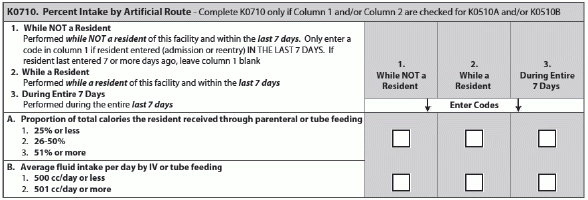Get Ready To Count Calories In Section K
Expect a FY 2013 transition RUG in only specific situations.
Take a quick look “under the hood” of the recently revised Resident Assessment Instrument (RAI) manual, and you’ll find some major changes to Section K: Swallowing/Nutritional Status. Specifically, you’ll now have a different way of coding the items for Nutritional Approaches and Percent Intake by Artificial Route.
Get the Skinny on What’s New
Updates: “Now, providers must specifically code the proportion of total calories a resident receives through an ‘artificial route,’” according to a recent blog posting by the Indianapolis-headquartered law firm Hall, Render, Killian, Health & Lyman. “This includes parenteral feeding and fluid intake by IV or tube feeding.”
You’ll also notice that on the MDS, K0700 is now K0710 — Percent Intake by Artificial Route, according to the Texas Department of Aging and Disability Services (DADS) in a Sept. 25 analysis of the RAI manual changes. And the manual adds to this item “While NOT a Resident” (Column 1), “While a Resident” (Column 2), and “During Entire 7 Days” (Column 3).
Here’s the official policy from the “Transition for Implementation of FY 2014 SNF PPS MDS 3.0 Policy Changes” document recently released by the Centers for Medicare & Medicaid Services (CMS):
“For all assessments with an ARD that is on or after Oct. 1, 2013 and on which a provider would be coding the resident’s swallowing and nutritional status, specifically the percent intake by Artificial Route, item K0710A and item K0710B must be coded with the proportion of total calories the resident received through parental or tube feeding and the average fluid intake per day by IV or tube feeding, respectively.”
More: Yet another addition to the manual is the following language added to Coding Tips for K0510D — Nutritional Approaches; Therapeutic Diet: “Food elimination diets related to food allergies (e.g. peanut allergy) can be coded as a therapeutic diet.”
Why You’ll See More Impact on Your RUG Grouper
“Interestingly enough, there are no specific coding instructions for Column 3, as there are for Columns 1 and 2,” in Item K0710, wrote MDS consultant Judy Wilhide Brandt, BA, RN, RAC-MT, in a recent summary and commentary for Washington, DC-based Leading Age. “And, on page 6-28 in the Medicare RUG grouper, the tube feeding RUG classification system now uses the new Column 3 to calculate the RUG, instead of Columns 1 and 2.”
So the tube feeding classification requirements are:
1) K0710A3 is 51 percent or more of total calories,
OR
2) K0710A3 is 26 percent to 50 percent of total calories and K0710B3 is 501 cc or more per day fluid enteral intake in the last seven days.
What Your Transition Will Look Like
For all assessments with an ARD before Oct. 1, CMS will not produce a fiscal year (FY) 2014 RUG. You will need to bill all days of service associated with that assessment using the FY 2013 RUG provided in Item Z0100A or Z0150A, even if some of those service days are on or after Oct. 1, CMS instructs.
Pay attention: But for all assessments with an ARD from Oct. 1 through Oct. 13, CMS will produce an FY 2013 transition RUG in situations where:
a. The value for non-oral calories in the last seven days (K0710A3) will be copied to the prior item (K0700A) for use by the FY 2013 grouper.
And for all assessments with an ARD after Oct. 13, CMS will no longer produce an FY 2013 transition RUG
b. The value for non-oral volume in the last seven days (K0710B3) will be copied to the prior item (K0700B) for use by the FY 2013 grouper. You should use this FY 2013 transition RUG to bill any days of service before Oct. 1 which are associated with that assessment. .
.

